新编实用英语综合教程2--Unit-2-Communication-by-Email教案
新编实用英语第二版综合教程二__课后答案
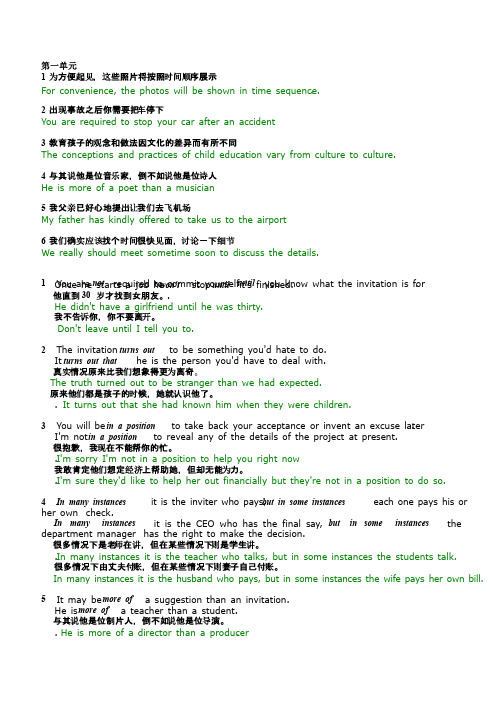
第一单元 1为方便起见,这些照片将按照时间顺序展示For convenience, the photos will be shown in time sequence.、 2出现事故之后你需要把车停下You are required to stop your car after an accident3教育孩子的观念和做法因文化的差异而有所不同The conceptions and practices of child education vary from culture to culture.4与其说他是位音乐家,倒不如说他是位诗人He is more of a poet than a musician5我父亲已好心地提出让我们去飞机场My father has kindly offered to take us to the airport6我们确实应该找个时间很快见面,讨论一下细节We really should meet sometime soon to discuss the details.1 You are not required to commit yourself until you know what the invitation is for . Once he starts a job he won't stop until it's finished. 他直到30岁才找到女朋友。
. He didn't have a girlfriend until he was thirty.我不告诉你,你不要离开。
Don't leave until I tell you to.2 The invitation turns out to be something you'd hate to do.It turns out that he is the person you'd have to deal with. 真实情况原来比我们想象得更为离奇。
新编实用英语综合教程2unit_2_教案

Unit TwoOnline Growth ContinuedTeaching ObjectiveIn "Talking Face to Face", learn how to give thanks and how to express regret.In "Being All Ears", practice listening comprehension to greet and introduce people with various relationships.In "Maintaining a Sharp Eye", master the key words and structures and learn the way foreign people greet each other, particularly the way Americans meet and greet each other, both in informal and formal situations by reading through passage I; learn and practice how to introduce oneself by reading through passage II.In "Trying Your Hand", become knowledgeable on how to write a business card and fill in a passport with one’s personal information; review the basic sentence structure. Teaching ProceduresSection I Talking Face to Face1.Warm- up:The patterns and expressions of Internet communication.Internet Phone (IP) 网络电话Internet paging 网上寻呼Internet chat 网上聊天computer dating service 电脑交友服务email address 电子邮件地址computer document 电脑文件Internet account 因特网账户User’s name 用户名domain name 域名AFAIK (As Far As I Know) 据我所知BF (Boy Friend) 男朋友FUQ (Frequently Unanswered Questions)经常无人回答的问题FYI (For Your Information) 仅供参考KISS (Keep It Simple, Stupid) 把它看简单些,傻瓜LOL (Laughing Out Loudly) 放声大笑PEM (Privacy Enhanced Mail) 保密邮件PMJI (Pardon My Jumping In) 请原谅我插入RIYP (Reply If You Please) 请答复ROTFL (Rolling On The Floor Laughing)捧腹大笑2. Practice the two dialogues in Follow the Samples3. Practice dialogues according to the given tasks4. ExercisesSection II Being All EarsSee the textbook.Section III Maintaining a Sharp EyePassage I Online Growth ContinuedText-related InformationWays for Internet Connection:There are several ways for Internet connection. One common way is dial-up connection. For dial-up connection, you need a computer, a modem, and a telephone line.ISP is the abbreviation of Internet Service Provider. It provides services for Internet users to get connected with the Internet. Before getting connected with the Internet, an Internet user must apply for an account and a password from an ISP. He or she should also get its dial-up number, the addresses of its domainname and of the mail server.Now you can turn on your computer, start the dial-up program and get connected with the Internet. Then you can use the browser to enjoy the world of Internet. You can also send or receive emails with the help of the emails.People can do a lot of things by browsing Internet, such as sharing information, transacting business and communicating with people across the globe.Text ExplanationPara.1In just five years,the World Wide Web has become a powerful new medium for sharing information, conducting business and communicating with people across the room or across the world.Language Points:1.Explanation of Difficult SentencesIn just five years,…Analysis:In just five years implies in the five years just past, and the main verb of the sentence usually takes present perfect tense. Across the room and across the world are given here to indicate the wide range of use of the Internet.Translation: 在仅仅5年的时间里,全球范围网已经成为一种新媒体,使人们能够从小到房间内大到全球范围分享信息、处理业务并相互流。
新编实用英语综合教程2主要内容
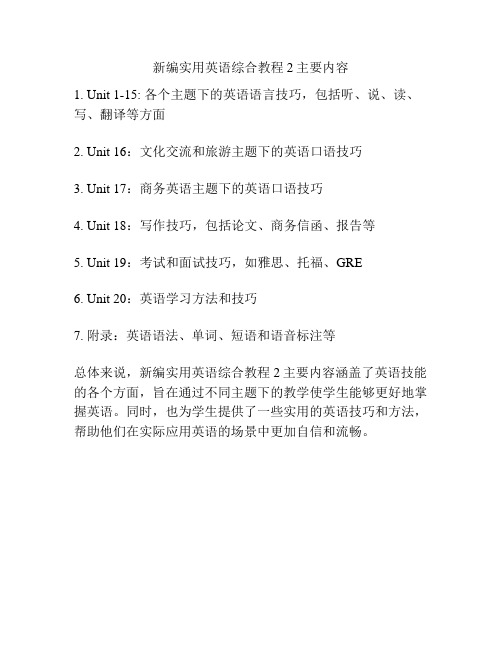
新编实用英语综合教程2主要内容
1. Unit 1-15: 各个主题下的英语语言技巧,包括听、说、读、写、翻译等方面
2. Unit 16:文化交流和旅游主题下的英语口语技巧
3. Unit 17:商务英语主题下的英语口语技巧
4. Unit 18:写作技巧,包括论文、商务信函、报告等
5. Unit 19:考试和面试技巧,如雅思、托福、GRE
6. Unit 20:英语学习方法和技巧
7. 附录:英语语法、单词、短语和语音标注等
总体来说,新编实用英语综合教程2主要内容涵盖了英语技能的各个方面,旨在通过不同主题下的教学使学生能够更好地掌握英语。
同时,也为学生提供了一些实用的英语技巧和方法,帮助他们在实际应用英语的场景中更加自信和流畅。
新编实用英语综合教程第二册第二单元
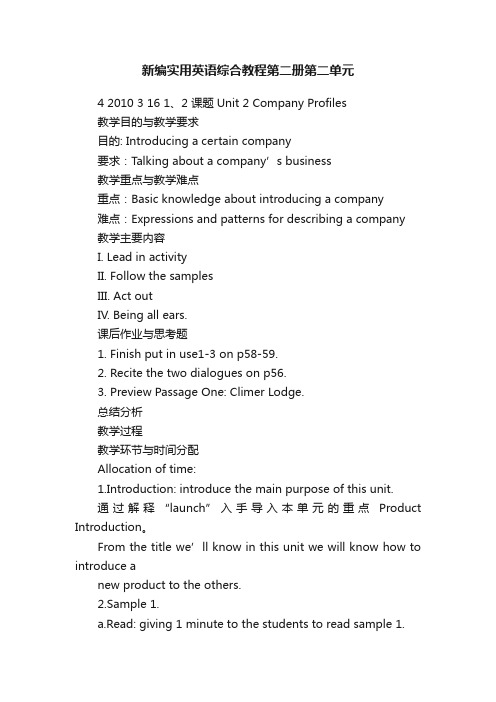
新编实用英语综合教程第二册第二单元4 2010 3 16 1、2 课题Unit 2 Company Profiles教学目的与教学要求目的: Introducing a certain company要求:Talking about a company’s business教学重点与教学难点重点:Basic knowledge about introducing a company难点:Expressions and patterns for describing a company教学主要内容I. Lead in activityII. Follow the samplesIII. Act outIV. Being all ears.课后作业与思考题1. Finish put in use1-3 on p58-59.2. Recite the two dialogues on p56.3. Preview Passage One: Climer Lodge.总结分析教学过程教学环节与时间分配Allocation of time:1.Introduction: introduce the main purpose of this unit.通过解释“launch”入手导入本单元的重点Product Introduction。
From the title we’ll know in this unit we will know how to introduce anew product to the others.2.Sample 1.a.Read: giving 1 minute to the students to read sample 1.b.Explanation.c.Analysis: What kinds of information can we get from this ad? 通过分析让学生了解在书写广告的时候要给出哪些信息。
新编实用英语综合教程2--Unit-3-Communication-by-phone教案
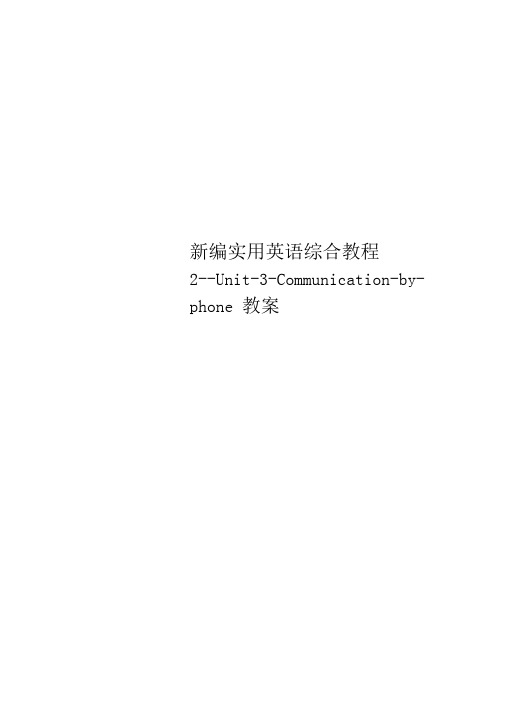
新编实用英语综合教程2--Unit-3-Communication-by- phone 教案Unit 3 Communication by Phone Unit GoalsWhat you should learn to do1.Make a phone call2.Answer the phone3.Leave and take a passage4.Pass the message to the person being called5.Extend a phone call6.Take/fill in a message What you should know about1.Phone service in the USA2.Benefit or trouble of cell phones3.Business telephone etiquette for success4.The subjective mood Section I Talking Face to Face1.Imitating Mini-Talks2.Acting out the Tasks3.Studying Email Information on the Internet4.Following Sample Dialogues5.Putting Language to UseSection II Being All Ears1.Learning Sentences for Workplace Communication2.Handling a Dialogue3.Understanding a Short Speech / TalkSection III Trying your Hand1.Practicing Applied Writing2.Writing Sentences and Reviewing GrammarSection IV Maintaining a Sharp EyePassage 1 :Information Related to the Reading Passage1.cell phone 手机,移动电话A cell phone is a small telephone you can carry with you that operatesthrough networks of radio antennas or space satellites. Other expressionsof a cell phone:1)a cellular phone / telephone2)a mobile phone / telephone3)a handset2.ATM 自动取款机ATM is the abbreviation for automated teller machine. ATMs are found in districts and shopping malls. People use them to get cash from their bank accounts and in many places, to pay for gas, groceries, and other things.3.voice mail 有声邮件A voice mail is a telephone answering system on which spoken messages are left by one person for another.Text For Conversation Press # 1I've got a cell phone, e-mail and voice mail. But why am I so lonely?A funny thing happened on the way to the communications revolution: we stopped talking to one another.I was walking in the park with a friend recently, and his cell phone rang interrupting our conversation. There they were, talking and talking on a beautifully sunny day and I became invisible, absent from the conversation.The park was filled with people talking on their cell phones. They were passing other people without looking at them, saying hello, noticing their babies or stopping to pet their puppies. Evidently, the cordless electronic voice is preferable to human contact.The telephone used to connect you to the absent. Now it makes people sittingnext to you feel absent. Recently I was in a car with three friends. The driver hushed the rest of us because he could not hear the person on the other end of his cell phone. There we were, four friends zooming down the highway, unable to talk to one another because of a gadget designed to make communication easier.Why is it that the more connected we get, the more disconnected I feel? Every advance in communications technology is a setback to the intimacy of human interaction. With e-mail and instant messaging over the Internet, we can nowcommunicate without seeing or talking to one another. With voice mail, you can conduct entire conversations without ever reaching anyone. If myon, mom has a questI just leave the answer on her machine.As almost every conceivable contact between human beings gets automated, the alienation index goes up. You can't even call a person to get the phone number o another person any more. Directory assistance is almost always fully automated.Pumping gas at the station? Why say good morning to the attendant when you can swipe your credit card at the pump and save yourself the bother of human contact?Making a deposit at the bank? Why talk to a clerk who might live in the neighborhood when you can just insert your card into the ATM?I am no Luddite. I own a cell phone, an ATM card, a voice mail system, an emai account. Giving them up isn't an option —they are great for what they are intended to do. It' s their unintended consequences that make me cringe.Language Points 1 Explanation of Difficult Sentences1.(Title) For Conversation Press # 1Analysis: In this sentence, for means with the purpose of. Press # 1 is in imperative mood. # stands for No., therefore #1 is read as No.1. Translation: 通话按 1 号键。
新编实用英语综合教程2-Unit2CommunicationbyEmail教案设计

Unit 2 Communication by Email Unit GoalsWhat you should learn to do1.Chat onlinee abbreviations and slangs in communicating online3.Write an emailWhat you should know about1.Surfing online for:InformationShopping2.Good or bad of chatting online3.Noun clausesSection I Talking Face to Face1.Imitating Mini-Talks2.Acting out the Tasks3.Studying Email Information on the Internet4.Following Sample Dialogues5.Putting Language to UseSection II Being All Ears1.Learning Sentences for Workplace Communication2.Handling a Dialogue3.Understanding a Short Speech / TalkSection III Trying your Hand1.Practicing Applied Writing2.Writing Sentences and Reviewing GrammarSection IV Maintaining a Sharp EyePassage 1 :Information Related to the Reading PassageIt’s no understatement to say that e-mail has had a profound effect on our professional and personal lives. People thousands of miles away from each other can send and receive detailed documents within mere seconds. This allows us to take on projects that wouldn’t have been practical or possible only a few years ago. It has become routine for us to correspond and exchange files with people overseas. The only obstacle is the difference in time zones.But on the other hand, e-mail can eat up a substantial portion of our workday. Most of the time and effort involved is going through unsolicited messages and separating the good from the bad. But not all unsolicited messages are spam.Text E-mail, a Blessing and AnnoyanceFor the blessing:E-mail is a conversation that does not require an immediate response (like a telephone). If someone calls you on the telephone, you pick it up (unless you have an answering machine, voice mail or you are just plain rude) and the conversation begins. This is an interactive conversation. With e-mail, you send a message and then wait for a response. The response may come in five minutes or it may come in five days. Either way, it’s not an interactive conversation.If a hundred people send you e-mails in one day, so what? You don’t have to talk with all one hundred. Just think of all the hellos, goodbyes and other unnecessary chit-chat you can avoid. With e-mail, you only deal with their messages (which usually omit hellos, goodbyes and such) and you deal with them on your own time. That’s the blessing.Now for the annoyance:Too many e-mail users assume that the minute someone receives ane-mail, the person will read it. Bad assumption.If you schedule a meeting for an hour from now and send an e-mail to each participant, the chance that all the participants will read that message within the hour will be pretty small. On the other hand, if you schedule the meeting for the next day, the chance that they will read the message will be pretty high. Remember, e-mail is not designed for immediate response (that’s why you have a telephone), it’s designed for convenience.Some (not all) e-mail systems have features that try to combat this problem. These features (usually called “notification”) will notify you when a person has received your e-mail and may also tell you when the person has read it (really all it can do is assure you that the person has looked at the first screen of the message — it has no way to know if the person has read the message word for word). Referring back to the example in the previous paragraph, you could check to see who has checked their e-mail before the meeting and then telephone those who have not read it.Attachment: SmiliesSince there are no facial and voice cues to help e-mail, users have come up with something called “smilies”. They are simple series of symbols that are pieced together in the e-mail text to help express the writer’s feelings. The most common example is :-) (a smiling face). Here are some more examples.They are typically found at the end of sentences and will usually refer back to the previous statement.Language Points1 Explanation of Difficult Sentences1. (Para. 3) If a hundred people send you e-mail in one day, so what?Analysis: so what? is an informal expression, which means “ Why should I care?”Translation: 如果在一天内有一百个人给你发邮件,那又怎么样呢?2. (Para. 3) Just think of all the hellos, good-byes and other unnecessary chit-chat you could avoid.Analysis: Just is used to make a statement or command stronger, meaning in Chinese “只是,仅仅”。
大学英语综合教程2-UNIT-2
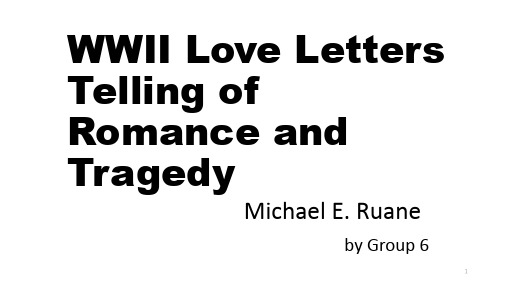
• 3 埃利奥特是退休护士,北卡罗来纳州达勒姆人。1993年,当她 终于捧读这些信件时,她被深深打动了。
6
7
Par. 4 When a family has a child.
• Frank M. Elliott, 23, who had left Georgetown University to join the Army in 1943, wrote from England. Pauline “Polly” Elliott, 24, wrote from their home in New Castle, Pa. Their daughter, DeRonda “Dee,” was a toddler.
• 8(诺曼底登陆前10天) • 1944年5月27日 • 嗨,亲爱的, • 跟你说吧,亲爱的,迪伊第一次去看电影,我当然想在她身边。带她去扬斯敦、匹兹堡或克利夫兰,去看看那些有着气派
新编实用英语综合教程2--Unit-2-Communication-by-Email教学导案
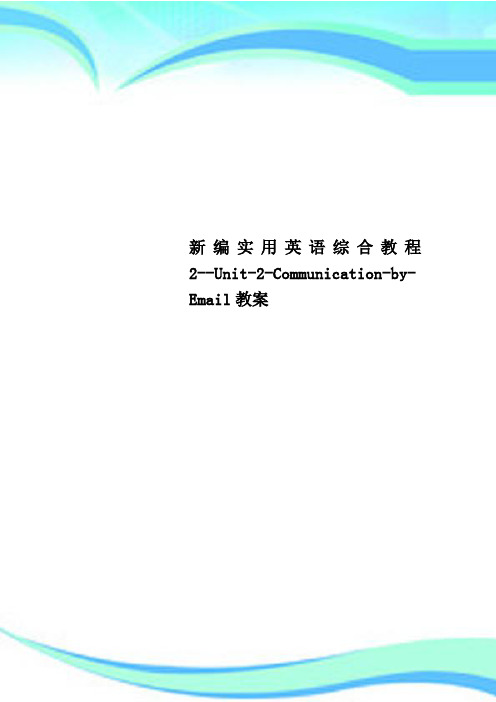
新编实用英语综合教程2--Unit-2-Communication-by-Email教案————————————————————————————————作者:————————————————————————————————日期:Unit 2 Communication by Email Unit GoalsWhat you should learn to do1.Chat onlinee abbreviations and slangs in communicating online3.Write an emailWhat you should know about1.Surfing online for:InformationShopping2.Good or bad of chatting online3.Noun clausesSection I Talking Face to Face1.Imitating Mini-Talks2.Acting out the Tasks3.Studying Email Information on the Internet4.Following Sample Dialogues5.Putting Language to UseSection II Being All Ears1.Learning Sentences for Workplace Communication2.Handling a Dialogue3.Understanding a Short Speech / TalkSection III Trying your Hand1.Practicing Applied Writing2.Writing Sentences and Reviewing GrammarSection IV Maintaining a Sharp EyePassage 1 :Information Related to the Reading PassageIt’s no understatement to say that e-mail has had a profound effect on our professional and personal lives. People thousands of miles away from each other can send and receive detailed documents within mere seconds. This allows us to take on projects that wouldn’t have been practical or possible only a few years ago. It has become routine for us to correspond and exchange files with people overseas. The only obstacle is the difference in time zones.But on the other hand, e-mail can eat up a substantial portion of our workday. Most of the time and effort involved is going through unsolicited messages and separating the good from the bad. But not all unsolicited messages are spam.Text E-mail, a Blessing and AnnoyanceFor the blessing:E-mail is a conversation that does not require an immediate response (like a telephone). If someone calls you on the telephone, you pick it up (unless you have an answering machine, voice mail or you are just plain rude) and the conversation begins. This is an interactive conversation.With e-mail, you send a message and then wait for a response. The response may come in five minutes or it may come in five days. Either way, it’s not an interactive conversation.If a hundred people send you e-mails in one day, so what? You don’t have to talk with all one hundred. Just think of all the hellos, goodbyes and other unnecessary chit-chat you can avoid. With e-mail, you only deal with their messages (which usually omit hellos, goodbyes and such) and you deal with them on your own time. That’s the blessing.Now for the annoyance:Too many e-mail users assume that the minute someone receives an e-mail, the person will read it. Bad assumption.If you schedule a meeting for an hour from now and send an e-mail to eachparticipant, the chance that all the participants will read that message within the hour will be pretty small. On the other hand, if you schedule the meeting for the next day, the chance that they will read the message will be pretty high. Remember, e-mail is not designed for immediate response (that’s why you have a telephone), it’s designed for convenience.Some (not all) e-mail systems have features that try to combat this problem. These features (usually called “notification”) will notify you when a person has received your e-mail and may also tell you when the person has read it (really all it can do is assure you that the person has looked at the first screen of the message —it has no way to know if the person has read the message word for word). Referring back to the example in the previous paragraph, you could check to see who has checked their e-mail before the meeting and then telephone those who have not read it.Attachment: SmiliesSince there are no facial and voice cues to help e-mail, users have come up with something called “smilies”. They are simple series of symbols that are pieced together in the e-mail text to help express the writer’s feelings. The most common example is :-) (a smiling face). Here are some more examples.They are typically found at the end of sentences and will usually refer back to the previous statement.Language Points1 Explanation of Difficult Sentences1. (Para. 3) If a hundred people send you e-mail in one day, so what?Analysis: so what? is an informal expression, which means “Why should I care?”Translation: 如果在一天内有一百个人给你发邮件,那又怎么样呢?2. (Para. 3) Just think of all the hellos, good-byes and other unnecessary chit-chat you could avoid.Analysis: Just is used to make a statement or command stronger, meaning in Chinese“只是,仅仅”。
新编实用英语综合教程2
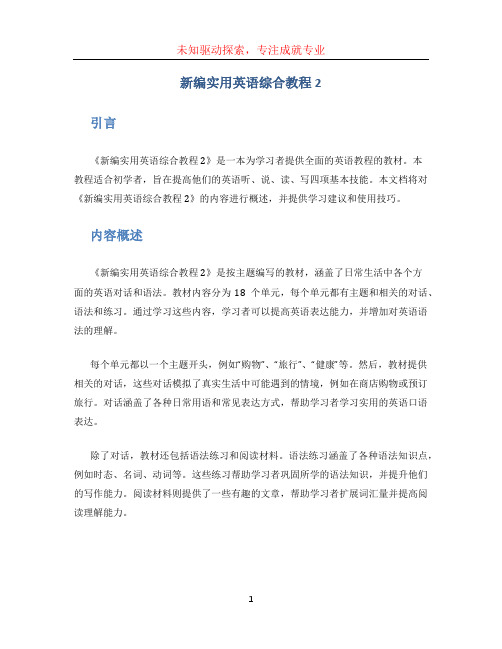
新编实用英语综合教程2引言《新编实用英语综合教程2》是一本为学习者提供全面的英语教程的教材。
本教程适合初学者,旨在提高他们的英语听、说、读、写四项基本技能。
本文档将对《新编实用英语综合教程2》的内容进行概述,并提供学习建议和使用技巧。
内容概述《新编实用英语综合教程2》是按主题编写的教材,涵盖了日常生活中各个方面的英语对话和语法。
教材内容分为18个单元,每个单元都有主题和相关的对话、语法和练习。
通过学习这些内容,学习者可以提高英语表达能力,并增加对英语语法的理解。
每个单元都以一个主题开头,例如“购物”、“旅行”、“健康”等。
然后,教材提供相关的对话,这些对话模拟了真实生活中可能遇到的情境,例如在商店购物或预订旅行。
对话涵盖了各种日常用语和常见表达方式,帮助学习者学习实用的英语口语表达。
除了对话,教材还包括语法练习和阅读材料。
语法练习涵盖了各种语法知识点,例如时态、名词、动词等。
这些练习帮助学习者巩固所学的语法知识,并提升他们的写作能力。
阅读材料则提供了一些有趣的文章,帮助学习者扩展词汇量并提高阅读理解能力。
学习建议•阅读对话:在学习每个单元时,首先阅读相关的对话。
尝试理解对话中使用的词汇和句型,并注意语音、语调和语气。
可以通过反复阅读对话来加深理解。
•学习语法:每个单元都包含语法练习,建议在阅读对话后先完成语法练习。
通过练习,巩固所学的语法知识,并在实际应用中提升自己的英语写作能力。
•扩展词汇:在阅读材料中,注意新词汇的学习。
每个单元都会提供一些生词和词组,建议将其记录下来并逐渐扩展自己的词汇量。
•口语练习:尝试模仿对话中的语音、语调和语气,并进行口头练习。
可以与同学或语伴进行对话练习,提高自己的口语表达能力。
使用技巧•利用语音资源:本教材配有语音资源,可以通过扫描二维码或使用电子设备进行访问。
学习者可以通过听取对话来提高听力和语音表达能力。
可以反复听取对话,并模仿语音和语调。
•创造情境:在学习对话时,可以尝试将对话中的情境创造出来。
新编实用英语综合教程2第四版Unit-two--Communication-by-email(课堂PPT)

Li Li: Really? What does it say?
Paul: New slang has been invented in recent years by students, especially as they
get access to the Internet and chat online.
4 Task: Discuss some slang words used in emails.
5 Task: Talk about the meaning of a new slang you’ve come across in your e-mail messages.
● Refer to the Data Bank in the Workbook for more relevant expressions.
Unit | Two
1 Unit | Two
Unit Goals:
What You Should Learn to Do
1. Chat online 2. Us e abbreviations and slangs in communicating online 3. Write an e-mail
Li Hong: Oh, really. I remember I once ran into “TTYL” while chatting with somebody online.
Let me have a guess. Does it mean “talk to you later”?
Back
Mike: That’s right. You are really smart.
Mike: Chatting online.
新编实用英语综合教程2--Unit-2-Communication-by-Email教案

Unit 2 Communication by Email Unit GoalsWhat you should learn to do1.Chat onlinee abbreviations and slangs in communicating online3.Write an emailWhat you should know about1.Surfing online for:InformationShopping2.Good or bad of chatting online3.Noun clausesSection I Talking Face to Face1.Imitating Mini-Talks2.Acting out the Tasks3.Studying Email Information on the Internet4.Following Sample Dialogues5.Putting Language to UseSection II Being All Ears1.Learning Sentences for Workplace Communication2.Handling a Dialogue3.Understanding a Short Speech / TalkSection III Trying your Hand1.Practicing Applied Writing2.Writing Sentences and Reviewing GrammarSection IV Maintaining a Sharp EyePassage 1 :Information Related to the Reading PassageIt’s no understatement to say that e-mail has had a profound effect on our professional and personal lives. People thousands of miles away from each other can send and receive detailed documents within mere seconds. This allows us to take on projects that wouldn’t have been practical or possible only a few years ago. It has become routine for us to correspond and exchange files with people overseas. The only obstacle is the difference in time zones.But on the other hand, e-mail can eat up a substantial portion of our workday. Most of the time and effort involved is going through unsolicited messages and separating the good from the bad. But not all unsolicited messages are spam.Text E-mail, a Blessing and AnnoyanceFor the blessing:E-mail is a conversation that does not require an immediate response (like a telephone). If someone calls you on the telephone, you pick it up (unless you have an answering machine, voice mail or you are just plain rude) and the conversation begins. This is an interactive conversation.With e-mail, you send a message and then wait for a response. The response may come in five minutes or it may come in five days. Either way, it’s not an interactive conversation.If a hundred people send you e-mails in one day, so what? Y ou don’t have to talk with all one hundred. Just think of all the hellos, goodbyes and other unnecessary chit-chat you can avoid. With e-mail, you only deal with their messages (which usually omit hellos, goodbyes and such) and you deal with them on your own time. That’s the blessing.Now for the annoyance:Too many e-mail users assume that the minute someone receives an e-mail, the person will read it. Bad assumption.If you schedule a meeting for an hour from now and send an e-mail to eachparticipant, the chance that all the participants will read that message within the hour will be pretty small. On the other hand, if you schedule the meeting for the next day, the chance that they will read the message will be pretty high. Remember, e-mail is not designed for immediate response (that’s why you have a telephone), it’s designed for convenience.Some (not all) e-mail systems have features that try to combat this problem. These features (usually called “notification”) will notify you when a person has received your e-mail and may also tell you when the person has read it (really all it can do is assure you that the person has looked at the first screen of the message —it has no way to know if the person has read the message word for word). Referring back to the example in the previous paragraph, you could check to see who has checked their e-mail before the meeting and then telephone those who have not read it.Attachment: SmiliesSince there are no facial and voice cues to help e-mail, users have come up with something called “smilies”. They are simple series of symbols that are pieced together in the e-mail text to help express the writer’s feelings. The most common example is :-) (a smiling face). Here are some more examples.They are typically found at the end of sentences and will usually refer back to the previous statement.Language Points1 Explanation of Difficult Sentences1. (Para. 3) If a hundred people send you e-mail in one day, so what?Analysis: so what? is an informal expression, which means “Why should I care?”Translation: 如果在一天内有一百个人给你发邮件,那又怎么样呢?2. (Para. 3) Just think of all the hellos, good-byes and other unnecessary chit-chat you could avoid.Analysis: Just is used to make a statement or command stronger, meaning in Chinese“只是,仅仅”。
新编实用英语(综合教程二课后习题答案全集)(NewpracticalEng..
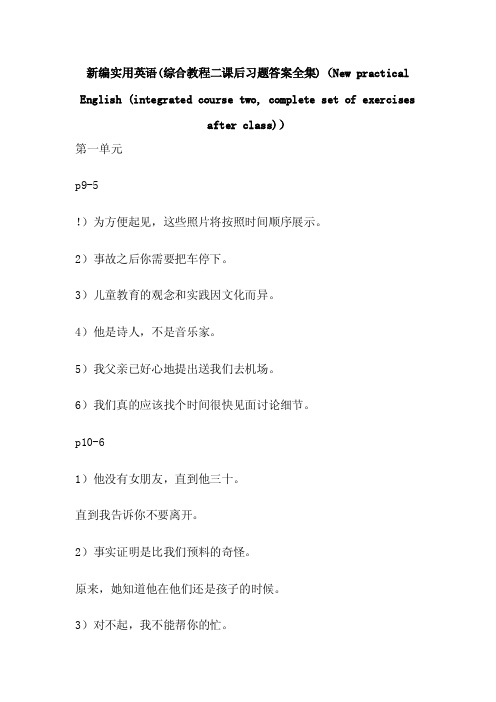
新编实用英语(综合教程二课后习题答案全集)(New practical English (integrated course two, complete set of exercisesafter class))第一单元p9-5!)为方便起见,这些照片将按照时间顺序展示。
2)事故之后你需要把车停下。
3)儿童教育的观念和实践因文化而异。
4)他是诗人,不是音乐家。
5)我父亲已好心地提出送我们去机场。
6)我们真的应该找个时间很快见面讨论细节。
p10-61)他没有女朋友,直到他三十。
直到我告诉你不要离开。
2)事实证明是比我们预料的奇怪。
原来,她知道他在他们还是孩子的时候。
3)对不起,我不能帮你的忙。
我肯定他们愿意在经济上帮助她,但他们没有能力这样做。
4)在许多情况下,是老师谈话,但在某些情况下,学生说话。
在可能情况下是丈夫付账,但在某些情况下,妻子自己付账。
5)他是一个比一个制片人导演。
他是一个作曲家而不是歌手。
6)有些房子看起来温暖但其实不是。
还有音乐,听起来像是轻音乐,但事实上不是。
p12-71t 2t 3t 4f 5f 6tp12-91。
似乎很长时间没收到你的来信了,从你到工作室算起,现在就更久了。
2。
所以我马上写信,好让你离开上海之前肯定能收到这封信,希望你们俩在英格兰逗留期间能和我们一起住几天。
三.我们还有两个朋友和我们一起度过新年的周末,所以,到时你也能来的话就太好了。
4。
而且如果我们遇上好天气的话,我们可以找一天一起出去拜访卡特一家。
5。
玛丽很好,而且喜欢她的教学工作(至少我这样认为),孩子们长得飞快,我还在桑德森公司工作,而且工作很称心,虽然偶尔我也会渴望从前自由自在的日子P13样品1很高兴能邀请你参加我们的年会。
今年会议将于7月24日到28日在布莱顿市的都城宾馆举行。
随信寄出会议的详尽日程,Room and board arrangement and activity plan.Last year you gave us a very lively statement entitled "high tech purchasing". We would appreciate it if you would consider giving us the latest development report on this subject.We shall appreciate it if you will confirm your attendance at the meeting as soon as possible.P13-sample 2In view of your letter of May 25th, I am pleased to inform you that I will attend the meeting in July this year.I would appreciate it if you could send me a more detailedschedule of meetings.Unfortunately, I can not make a fresh addition to last year's speech. I am busy with the work and I have no time to prepare.In any case, I am looking forward to attending the meeting again.P14-2It's my pleasure to invite you to our annual meeting. This year's conference will be held at University of Nottingham in August 20th.Send details of the meeting, accommodation and business activities plan.Last year you made a very interesting report entitled "academic standards and expectations". We would appreciate it if you could give us a speech on the latest developments in this subject.We shall appreciate it if you will let us know as soon as possible at your convenience.P14-3()) confirm, my, participation, in, this, year's, conference, in, August,()) you, could, send, me, further, details, about, the,programe,()) I, will, not, be, able, to, give, an, update, on,, last, time's, talk4),工作压力不允许时间准备谈一谈。
新编实用英语综合教程2 -Unit 2 Communication by Email教案

Unit 2 Communication by EmailUnit GoalsWhat you should learn to do1.Chat onlinee abbreviations and slangs in communicating online3.Write an emailWhat you should know about1.Surfing online for:InformationShopping2.Good or bad of chatting online3.Noun clausesSection I Talking Face to Face1.Imitating Mini-Talks2.Acting out the Tasks3.Studying Email Information on the Internet4.Following Sample Dialogues5.Putting Language to UseSection II Being All Ears1.Learning Sentences for Workplace Communication2.Handling a Dialogue3.Understanding a Short Speech / TalkSection III Trying your Hand1.Practicing Applied Writing2.Writing Sentences and Reviewing Grammar Section IV Maintaining a Sharp EyePassage 1 :Information Related to the Reading PassageIt’s no understatement to say that e-mail has had a profound effect on our professional and personal lives. People thousands of miles away from each other can send and receive detailed documents within mere seconds. This allows us to take on projects that wouldn’t have been practical or possible only a few years ago. It has become routine for us to correspond and exchange files with people overseas. The only obstacle is the difference in time zones.But on the other hand, e-mail can eat up a substantial portion of our workday. Most of the time and effort involved is going through unsolicited messages and separating the good from the bad. But not all unsolicited messages are spam.Text E-mail, a Blessing and AnnoyanceFor the blessing:E-mail is a conversation that does not require an immediate response (like a telephone). If someone calls you on the telephone, you pick it up (unless you have an answering machine, voice mail or you are just plain rude) and the conversation begins. This is an interactive conversation.With e-mail, you send a message and then wait for a response. The response may come in five minutes or it may come in five days. Either way, it’s not an interactive conversation.If a hundred people send you e-mails in one day, so what? You don’t have to talk with all one hundred. Just think of all the hellos, goodbyes and other unnecessary chit-chat you can avoid. With e-mail, you only deal with their messages (which usually omit hellos, goodbyes and such) and you deal with them on your own time. That’s the blessing.Now for the annoyance:Too many e-mail users assume that the minute someone receives an e-mail, the person will read it. Bad assumption.If you schedule a meeting for an hour from now and send an e-mail to eachparticipant, the chance that all the participants will read that message within the hour will be pretty small. On the other hand, if you schedule the meeting for the next day, the chance that they will read the message will be pretty high. Remember, e-mail is not designed for immediate response (that’s why you have a telephone), it’s designed for convenience.Some (not all) e-mail systems have features that try to combat this problem. These features (usually called “notification”) will notify you when a person has received your e-mail and may also tell you when the person has read it (really all it can do is assure you that the person has looked at the first screen of the message —it has no way to know if the person has read the message word for word). Referring back to the example in the previous paragraph, you could check to see who has checked their e-mail before the meeting and then telephone those who have not read it.Attachment: SmiliesSince there are no facial and voice cues to help e-mail, users have come up with something called “smilies”. They are simple series of symbols that are pieced together in the e-mail text to help express the writer’s feelings. The most common example is :-) (a smiling face). Here are some more examples.They are typically found at the end of sentences and will usually refer back to the previous statement.Language Points1 Explanation of Difficult Sentences1. (Para. 3) If a hundred people send you e-mail in one day, so what?Analysis: so what? is an informal expression, which means “Why should I care?”Translation: 如果在一天内有一百个人给你发邮件,那又怎么样呢?2. (Para. 3) Just think of all the hellos, good-byes and other unnecessary chit-chat you could avoid.Analysis: Just is used to make a statement or command stronger, meaning in Chinese“只是,仅仅”。
原创新编实用英语综合教程2第三版Unit 2 Communication by Email

我的笑天出(猪惊叫讶) ②
我如的果天我(没惊记讶错) ④
没问顺题便;说不一用句谢 ⑪
如果我谢没谢记错 ⑨
供您谢参谢考
⑩
马没上关回系来
⑫
信息开量玩太笑大 ⑭
亲回亲头抱再抱聊
⑮
随谢便谢问
⑬
顺便谢说谢一句 ③
没问回题头;再不聊用谢 ⑧
马没上关回系来
⑥
笑随出便猪问叫
①
信开息玩量笑太大 ⑦
供亲您亲参抱考抱
⑤
Internet Slangs
I like innovation. I like what I see. I know people. I know that patience has its limits.
Grammar: Noun Clause
What I say is true. 主语 What I had forgotten was that I had a test today. 表语 Show me how they work. 宾语 I understand why it was necessary. 宾语 I'm not looking for what he likes. 宾语 We decided to look into how much it costs. 宾语 Harry's problem was that he couldn't make a decision. 表语 The uncertainty is whether he will attend or not. 表语
Grammar: Noun Clause
Noun Clause Markers 名词性从句标志词
• that • if, whether • Question words (how, what, when, where,
- 1、下载文档前请自行甄别文档内容的完整性,平台不提供额外的编辑、内容补充、找答案等附加服务。
- 2、"仅部分预览"的文档,不可在线预览部分如存在完整性等问题,可反馈申请退款(可完整预览的文档不适用该条件!)。
- 3、如文档侵犯您的权益,请联系客服反馈,我们会尽快为您处理(人工客服工作时间:9:00-18:30)。
Unit 2 Communication by Email Unit GoalsWhat you should learn to do1.Chat onlinee abbreviations and slangs in communicating online3.Write an emailWhat you should know about1.Surfing online for:InformationShopping2.Good or bad of chatting online3.Noun clausesSection I Talking Face to Face1.Imitating Mini-Talks2.Acting out the Tasks3.Studying Email Information on the Internet4.Following Sample Dialogues5.Putting Language to UseSection II Being All Ears1.Learning Sentences for Workplace Communication2.Handling a Dialogue3.Understanding a Short Speech / TalkSection III Trying your Hand1.Practicing Applied Writing2.Writing Sentences and Reviewing GrammarSection IV Maintaining a Sharp EyePassage 1 :Information Related to the Reading PassageIt’s no understatement to say that e-mail has had a profound effect on our professional and personal lives. People thousands of miles away from each other can send and receive detailed documents within mere seconds. This allows us to take on projects that wouldn’t have been practical or possible only a few years ago. It has become routine for us to correspond and exchange files with people overseas. The only obstacle is the difference in time zones.But on the other hand, e-mail can eat up a substantial portion of our workday. Most of the time and effort involved is going through unsolicited messages and separating the good from the bad. But not all unsolicited messages are spam.Text E-mail, a Blessing and AnnoyanceFor the blessing:E-mail is a conversation that does not require an immediate response (like a telephone). If someone calls you on the telephone, you pick it up (unless you have an answering machine, voice mail or you are just plain rude) and the conversation begins. This is an interactive conversation.With e-mail, you send a message and then wait for a response. The response may come in five minutes or it may come in five days. Either way, it’s not an interactive conversation.If a hundred people send you e-mails in one day, so what? You don’t have to talk with all one hundred. Just think of all the hellos, goodbyes and other unnecessary chit-chat you can avoid. With e-mail, you only deal with their messages (which usually omit hellos, goodbyes and such) and you deal with them on your own time. That’s the blessing.Now for the annoyance:Too many e-mail users assume that the minute someone receives an e-mail, the person will read it. Bad assumption.If you schedule a meeting for an hour from now and send an e-mail to eachparticipant, the chance that all the participants will read that message within the hour will be pretty small. On the other hand, if you schedule the meeting for the next day, the chance that they will read the message will be pretty high. Remember, e-mail is not designed for immediate response (that’s why you have a telephone), it’s designed for convenience.Some (not all) e-mail systems have features that try to combat this problem. These features (usually called “notification”) will notify you when a person has received your e-mail and may also tell you when the person has read it (really all it can do is assure you that the person has looked at the first screen of the message —it has no way to know if the person has read the message word for word). Referring back to the example in the previous paragraph, you could check to see who has checked their e-mail before the meeting and then telephone those who have not read it.Attachment: SmiliesSince there are no facial and voice cues to help e-mail, users have come up with something called “smilies”. They are simple series of symbols that are pieced together in the e-mail text to help express the writer’s feelings. The most common example is :-) (a smiling face). Here are some more examples.They are typically found at the end of sentences and will usually refer back to the previous statement.Language Points1 Explanation of Difficult Sentences1. (Para. 3) If a hundred people send you e-mail in one day, so what?Analysis: so what? is an informal expression, which means “Why should I care?”Translation: 如果在一天内有一百个人给你发邮件,那又怎么样呢?2. (Para. 3) Just think of all the hellos, good-byes and other unnecessary chit-chat you could avoid.Analysis: Just is used to make a statement or command stronger, meaning in Chinese“只是,仅仅”。
Translation: 只要想想看,你能省掉的所有“你好”、“再见”以及其他一些没有必要的寒暄,这就够了。
Example: But I bet they work too hard. Just think of all they miss.Example: Sometimes it can take a little bit longer, but so what?3. (Para. 5) If you schedule a meeting for an hour from now and send an e-mail to each participant, the chance that all the participants will read that message within the hour will be pretty small.Analysis: This is a complex sentence. The subject and the predicate of the main clause are the chance and will be pretty small, with a that-clause to modify the chance ; If you schedule a meeting for an hour from now and send an e-mail to each participant is an adverbial clause of condition.Translation: 如果你计划从现在起的一小时后开一个会,然后给每一位与会的人发一封电子邮件,所有与会的人都能在一小时内读到该邮件的机率是很小的。
